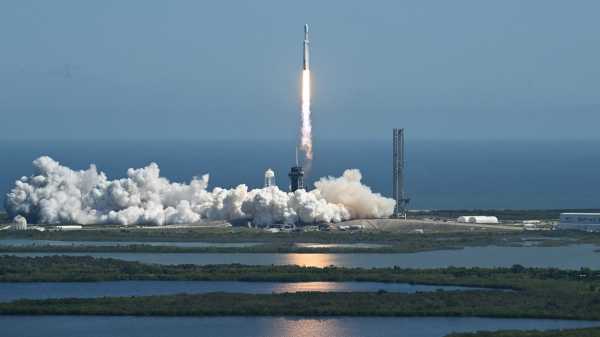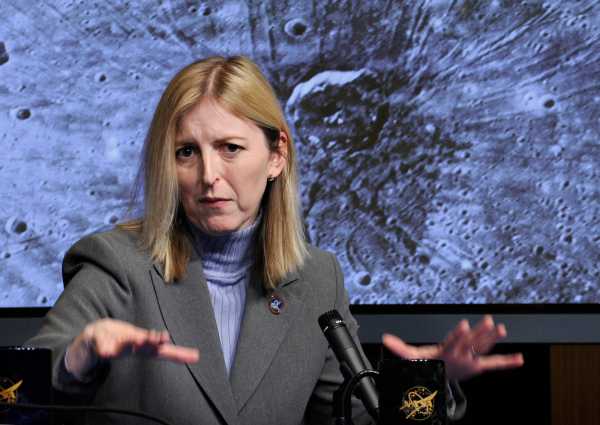
Save this storySave this storySave this storySave this story
Just after noon on Monday, a SpaceX rocket stood on the same launchpad that once sent men to the moon. Hurricane Milton had recently ripped across Florida, whipping up winds of a hundred miles per hour in Cape Canaveral, but now the skies were a featureless blue. From a restricted viewing area not far away, Louise Prockter, a graceful scientist with sandy hair, glanced at a countdown clock and then back at the rocket, which carried her lifework. “Surreal,” she said softly. “This just doesn’t feel real.” There were three minutes until ignition.
On top of the rocket was Europa Clipper, a spacecraft about the size of a basketball court which is destined for one of Jupiter’s most enigmatic moons. Europa, which is roughly the size of our moon, is a striking ball of blue ice crisscrossed with crimson cracks. Galileo discovered it orbiting Jupiter in 1610, demonstrating in the process that the Earth might not be the center of the universe. Beneath Europa’s frozen shell is a liquid salt-water ocean: perhaps the most likely place in the solar system to harbor alien life. Crucially, its interior is also warmed by a gravitational tug-of-war between its parent planet and fellow-moons. As a result, Europa’s rocky mantle likely spews heat and nutrients into its ocean—creating conditions that, over billions of years, could have turned chemistry into biology.
But the cosmic forces that make Europa special also make it treacherous for spacecraft. Jupiter’s powerful magnetic field traps particles and accelerates them to large fractions of light speed, creating powerful belts of radiation. The most prominent source of those particles is Io, the neighboring volcanic moon. Europa Clipper will have to endure the level of radioactivity that would be produced by a thermonuclear war.
When Prockter talks about her job—chief scientist of space exploration at the Johns Hopkins University Applied Physics Laboratory (A.P.L.)—she often half smiles, as though in recognition of the absurd grandeur of space exploration. As the launch approached, she had a kind of energetic calm. She hoped that the rocket wouldn’t blow up; she thought about her family, who were proudly watching a live stream in the U.K. She thought about how far the Europa Clipper team had come, and how the spacecraft was only beginning its journey. The countdown continued.
The total cost of Europa Clipper is about five billion dollars, comparable to previous NASA flagships such as the Cassini mission. But the real cost of this voyage has been time. Prockter was thirty years old when she first learned about Europa. She was involved in a seventeen-year struggle to win scientific support for a mission there. Then came a decade-long engineering effort to build a suitable spacecraft. Even now, Clipper will need almost six years to reach Jupiter and another four to study Europa—at which point Prockter will be around seventy. Several of her senior colleagues didn’t live long enough to see this day.
“I don’t think people understand how hard it is to explore the outer solar system,” Prockter told me. “But that’s where the potential for life is. We’re not going to find it at Mars or Venus. If we’re serious, and NASA’s serious, that’s where we need to go. But it needs to happen faster.”
Prockter has grown tired of waiting. Last month, she told team members that she’s retiring; watching Europa Clipper lift off was among her last official acts at A.P.L. She will not be moving on to a lucrative space-industry job or a prestigious professorship but to a small woodshop in the mountains of West Virginia. “I have a need to produce things I can feel and smell,” she told me. “Something that will last, that is very much of humans and of this Earth, and not flying into space where I’ll never see or touch it again.” Planetary science has always been a study from afar. Even when Neil Armstrong walked on the moon, he didn’t actually touch it.

Louise Prockter is pictured in 2008, at a news conference on images of Mercury captured by a NASA probe.Photograph by Bill Ingalls / NASA / Reuters
Louise Prockter was born in 1964 to a working-class London family. As a teen-ager, she told me, she spent Saturday nights “buying a quarter bottle of vodka and sneaking over the park with a bunch of ne’er-do-wells, until the police came.” This continued into her twenties: too many rounds at pubs and clubs, too many mornings of aspirin and regret. In a moment of clarity, at twenty-five, she enrolled at the Open University, a correspondence college in the United Kingdom. She was surprised by her own aptitude for science and soon transferred to Lancaster University as a full-time student. In her final year, she studied something she’d never heard of—planetary science. Her professor pressed students to inspect images of planets and ask questions about them.
Then, in 1994, shortly before NASA’s Galileo spacecraft reached Jupiter, Prockter became a graduate student at Brown University, studying under a co-investigator of the mission’s imaging campaign. She told me that she was “seduced by Galileo” and mesmerized by images of Jupiter’s moons—volcanic Io, frozen Europa, piebald Ganymede, speckled Callisto.
Galileo had been built in the eighties and used a reel-to-reel memory system. On an iPhone, its images would be about the size of postage stamps. “Galileo was so limited in terms of the data transmission,” Zibi Turtle, who was on the mission’s imaging team, and who now oversees Europa Clipper’s cameras, told me. Researchers had to make scientific arguments for directing its camera this way or that. “You really had to start coördinating and thinking like a scientist,” Turtle said.
As an early-career planetary geologist, Prockter joined A.P.L., where she studied outer planets, an asteroid, and, during the MESSENGER mission, Mercury. “Louise has a knack for seeing details that the rest of us just look past,” Robert Pappalardo, who first worked with her at Brown, told me. In December, 1999, while scrutinizing photographs of Europa, she noticed subtle shading in a small fault line: the first unequivocal evidence of “compression” on Europa. It suggested complex geologic activity, advancing the case for an ocean below. Pappalardo was astounded. “I must have looked at those images a million times,” he said. They co-authored a paper for the journal Science; today, he is the scientific lead for the Europa Clipper mission.
Meanwhile, scientists turned Galileo’s magnetometer toward Europa. Jupiter’s magnetic field, they found, generated an odd electromagnetic current inside the frozen moon. Only one thing could fit the signal’s behavior: a subsurface, salt-water ocean. “The term ‘ocean world’ wasn’t even used back then,” Pappalardo told me. Europa’s ocean was the biggest in the solar system and twice the size of Earth’s oceans combined. The discovery “spawned a revolution,” Prockter told me. “Everything suddenly made sense . . . this amazing, coherent geological story.”
E-mails flew feverishly between Pappalardo, Prockter, and a handful of collaborators. The Galileo mission would be poisoned by radiation by 2003; they needed to get a new spacecraft there soon. In practice, however, the effort required them to wait two decades, attend thousands of meetings, give hundreds of talks, and write four major studies totalling more than fifteen hundred pages.
In 2014, while studying an old Galileo image, Prockter noticed features that resembled zones on the Earth’s seafloor, which suggested that Europa’s ice slabs moved like Earth’s plates. It was a radical notion—“real career-ending stuff” if she was wrong, Prockter told me. She shared images with Simon Kattenhorn, a geologist who was skeptical that the moon could support plate tectonics. “I don’t know what’s going on there,” he admitted. They corresponded for the next year. Finally, he took a sabbatical and joined her at A.P.L. They printed poster-size images of Europa and he cut them up with scissors, sliding shapes around like pieces of a jigsaw puzzle. “It was like kindergarten,” he told me. Vast sections, they saw, appeared to be vanishing, pushed below the surface. Jupiter’s extreme radiation made Europa’s surface oxygen-rich; if plate tectonics helped feed that material into the ocean, the oxygen could foster complex organic molecules and even life. Prockter soon earned what she jokingly called “the accolade that all scientists strive for,” when their discovery was written into a two-hundred-dollar “Jeopardy!” question.
The following year, NASA formally approved the Europa Clipper mission. Then, in 2017, NASA’s Jet Propulsion Laboratory asked Prockter to propose a mission to Triton, Neptune’s largest moon. Triton has its own ice shell and subsurface ocean atop a rocky seabed, and this suggests that it, too, might have the ingredients of life; NASA had explored it only once, for a few hours in 1989. The mission that she and her team came up with, Trident, aimed to confirm that the “habitable zone” of the solar system—once thought to be Venus, Earth, and Mars—is, in fact, the entire solar system. Life could be everywhere.
The next four years were the busiest of Prockter’s career. Trident was a once-in-a-century mission: NASA needed to approve the proposal by 2022 in order for the spacecraft to reach Triton by 2038. After that, the south pole of Triton would be shrouded in darkness until the twenty-second century. But scientists who study the outer planets face severe disadvantages compared with those who study our planetary neighbors. Prockter said in a recent talk that the head of NASA space science told her that he “didn’t want to wait thirteen years in cruise,” while Trident was covering the vast distance to Neptune, “for a ten-day encounter.” Missions that don’t take as long, or which have a longer data-gathering period, can be better for public relations.
In the end, NASA passed over her proposal, deciding to go to Venus instead. “After years of effort . . . that sense of loss, nothing could have prepared me for,” Prockter told me. In another moment of clarity, she assessed her situation. By her math, she had already worked as much as someone a decade older. Her days increasingly consisted of soul-deadening meetings and consultations. One day, while driving to the local Goodwill to drop off some donations, she noticed a sign in a strip-mall window which said “Woodworking lessons.” Although she continued to work on the Clipper mission, she started to take classes on her own time.
In July, 2023, Prockter sent me a surprising text message. “I just don’t know what I’m supposed to do with myself after Clipper launches,” she wrote. “But I have set up a pretty nice woodshop in my cabin in the woods. So that’s my third career plan.” At first, I thought she was making a wry joke. But the next day she left for a two-week workshop on hand tools. Two months later, she attended a class on carving.
In late August, I visited Prockter at her cabin, which is sparsely decorated, with slightly wilted plants in colorful vases near a fireplace. Tables hold stacks of Australian Wood Review. In her living room, I noticed an elegant box made from African mahogany resting on a polished end table. She had made both. “There are a lot of elements that come together to make something like that—something hopefully beautiful, functional, that is going to last a long time,” she said. “That’s what we did on Clipper.”
We descended an unfinished staircase to a woodshop equipped with saws, shelves, shop vacs, and stacks of wood. “I want to show you something I made in class,” she said. “It’s not my design, but I may have made some modifications.” She presented a handmade redwood box with rounded edges, the sort of container that might hold love letters. The lid’s dark, varnished inlay seemed to swirl and shimmer like the surface of Venus. “When you slice through a tree’s burl, you see a pattern like this,” she said. “I knew it had to be my lid.”
Prockter made the decision to retire because of time. NASA’s approach to ambitious missions did not leave enough years to make anything else for the outer solar system. She only had time to make things on Earth. On top of a heavy-duty toolbox in her workshop, I saw a half-scale model of a Little Free Library. It is based on the New York Public Library and made of thick white poster board, cut into panels and pasted together. There are two ceramic lions—formerly salt and pepper shakers—at the library’s “entrance.” On a nearby notepad, she had sketched angles and equations to improve its design. Peering inside the model, I could see that the poster board was the blank side of a sign advertising a 2023 lecture at Penn State. The speaker that year was Dr. Louise Prockter.
On launch day, Prockter was disappointed that hurricane logistics prevented her husband, Peter Bedini, a project manager at A.P.L., from joining her. When he announced his own retirement, not long before she did, he quipped that he “wanted to spend less time with his family.” At T minus one minute, she looked around at her surrogate family, including Pappalardo and his wife, Mabel, and Curt Niebur, who spent twenty-two years ushering the mission along from NASA headquarters. There have been years when Prockter saw them about as much as her actual family.
During the final ten seconds, Prockter and hundreds of members of the Europa Clipper team shouted the countdown. At one, the boosters ignited, and the audience experienced them in three phases. First we saw it—the plumes billowed out like an inverted volcano. Next we heard it, a crackling apocalyptic roar. Finally we felt it, in our heads and rib cages and beneath our feet. Our keys rattled in our pockets.
The rocket lifted away slowly, as though in contemptuous defiance of physics. It was pushed along by three tongues of white flame. Minutes later, it was nearly gone—just another dot in the sky. In space-flight circles, there is a saying: Going a billion miles is easy—once you’ve escaped Earth’s gravity, there’s nothing to slow you down—but getting one inch from Earth is very, very hard. Prockter watched Europa Clipper go. Then she turned away from the spectacle, toward the world it left behind. ♦
Sourse: newyorker.com







